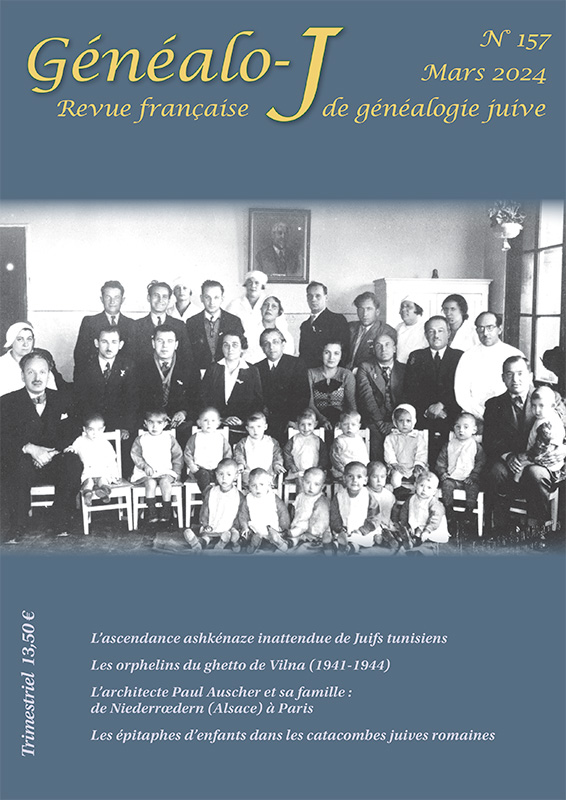
Gilles Boulu
The unexpected Ashkenazi ancestry of Tunisian Jews. Genetic genealogy of the maternal lineage and mitochondrial DNA testing
A mitochondrial DNA test analyzing mutations in the author’s maternal lineage revealed a surprise : an unexpected Ashkenazi origin among his ancestors from the indigenous Jewish community of Tunis and the discovery of numerous Jewish genetic « cousins » from Eastern Europe. Gilles Boulu attempts to unravel this mystery by reconstructing the entire migration of his matrilineal lineage over millennia using archeogenetics, and then formulates hypotheses on the different routes taken by his ancestors to arrive in Tunisia.
Muriel Chochois
The orphans of the Vilna ghetto (1941-1944)
On 6 September 1941, the Jews who had survived the two months of German occupation of Vilna (now Vilnius, the capital of Lithuania) were locked up in a ghetto. On the 15th, the Lithuanian authorities drew up a list of 28 Jewish children who had previously been housed in Orphanage No. 1, and who were placed under the authority of the Jewish Council on that day. For these young children, for all the children in the ghetto, teachers, artists and doctors took action. Among them was Dr Roza Shabad-Gawronska, a paediatrician and former president of the Vilnois branch of the Association for the Protection of the Health of the Jewish Population in Poland, who proposed and directed organisations dedicated to very young children. This article tells the story of Dr Shabad-Gawronska and the search for the names of the children in this orphanage, with whom she remained when the ghetto was liquidated on 23 September 1943.
Anne-Marie Fribourg
The architect Paul Auscher (1866-1932) and his family. From Niederroedern (Alsace) to Paris.
from a remarkable building on the rue de Rennes in Paris, the author traces the roots of the architect, who came from an Alsatian family. In the course of his work, particularly on department stores throughout France, she discovers the role of family networks and the evolution of architectural styles in the early 20th century.
Marie-Laure Rebora
The children’s epitaphs in the Roman Jewish catacombs (2nd-4th centuries AD), an onomastic and genealogical study
This article looks at the history of Roman Jewish communities in Late Antiquity, based on rich sources that have long been overlooked by researchers : the thirty-five epitaphs of children from the Jewish catacombs of Vigna Randanini, located near the Via Appia (2nd-4th centuries AD). We have chosen to select six of these epitaphs, which allow us to sketch out an onomastic and genealogical study of the deceased children and their families, sometimes spanning several generations. This approach remains exceptional and opens the way to a number of genealogical investigations and hypotheses worthy of interest for enthusiasts in these fields of research.
Read on line and download (for subscribers only)